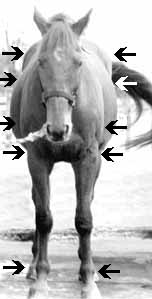 ASYMMETRY What does it mean when a horse is described as “asymmetrical?” It’s when the size, shape or position of the horse’s body on the right side is different from its corresponding part on the left side. People, too, usually have some degree of asymmetry.
And just like people, horses tend to be right- or left-handed, or in their case, footed. Although others in different parts of the country experience a different trend, most of the horses I meet tend to be left-handed (ie, dominant left fore) which often shows up as a horse who is contracted on the right. This “handedness” can lead to uneven development in the horse’s body, although injuries and other outside influences can also contribute to compensatory movement which then becomes a habit. Asymmetry may create lameness and/or movement problems, may throw the rider off-balance, and may also masquerade as a training, behavioral, or attitude issue. Typical symptoms include resentment or hypersensitivity during grooming, saddling and/or mounting; reluctance to take a particular canter lead; difficulty bending in one direction under saddle (usually to the left); rider slipping off to one side, and sometimes the saddle, too; irregular rhythm or stride length; one front foot more upright than the other (usually the right, which is also usually the side of the mane at the withers); tilting of the head (ears not level). Asymmetry can be aggravated by rider interference, poor saddle fit, hoof imbalances, the need for dental work, and injury. Asymmetry can frequently be improved, but first you must identify it and determine whether it is being caused or aggravated by something you are doing—or perhaps not doing. Identifying
Asymmetry Stand behind him and examine his hips. Take a good look. You may wish to place a colored sticker on each hip to help you see uneven development. Is he equally well developed, equally round, on both sides of his hindquarters? Absolutely do nitpick…subtle differences count. Is one hip higher or rounder or fuller than the other? Is the point of his croup on both sides of the spine equal in height? Is his tail centered or does he carry it slightly to one side? Move the tail so you can see the back of the hind legs. Do the upper hind legs join the hocks at the same angle in both legs? How about the angle of his hind cannons? Are his hind feet turned out equally? Are the muscles on the insides of the hind legs developed the same in both legs? How about the muscles on the outside of the hindlegs? Are the points of his buttocks, just below the top of his tail, the same height? Is one more prominent than the other? If your horse will permit it, stand on something behind him and reach around his quarters to place a finger on each point of hip. Is one further forward than the other? Higher than the other? Now look along his back towards his withers. If necessary, stand on something so you get a good view. Does his spine lie in a straight line from the tail all the way to the ears? Or does it have a curve in it in one or more places? Is the loin area equally well developed on both sides of the spine? Does the loin muscle extend the same distance on both sides? Now focus on the withers area. Are the withers in line with a straight spine? Do they lean slightly to one side? Is the top of the shoulder on one side more prominent than the other? Is there more of a hollow behind one shoulderblade than the other? Is there a curve in the crest of the neck? Does the mane flip over part-way up the neck? More than once? Are the ears level? Now move to your horse’s shoulder, and with him still standing square, locate the front edge of the scapula (shoulder blade). Run your finger up this edge, and at the top continue the movement in a straight line to the crest of his neck. Mark with chalk or have a friend keep a finger at this exact location on the crest while you move to the other side of the horse, and repeat the process there. Do the lines meet at the top of the crest, or is one further forward than the other? Now crouch down directly in front of your
horse. He should still be standing square. Examine the
area just above the front of the shoulder-blade, where
the neck ties in. Is this more developed on one side?
Look at his chest and locate the points of the shoulder
at the lower end of the scapula; palpate to find them if
necessary and place a fingertip on each. Are they exactly
the same height? Is one further forward than the other?
Is one more prominent than the other? Look at the chest
between his front legs. Is the lower edge level — it
may look like an inverted V, but is one side lower? From
where you’re standing, look at his barrel. Can you
see more of it on one side of the horse than on the
other? These are just some of the more obvious and easiest places to look for asymmetry, and even here the symptoms may be subtle. And if asymmetry shows up at all in any of these places, the horse’s balance may be affected, and thus performance. Some horses show these effects more than others. In general the bulkier-muscled, and in some cases less sensitive horses will tend to tolerate the effects better, and they may show the effects in a slight balkiness, if at all. However, they are still being stressed. | Riding Theory Main Page | Asymmetry | Asymmetry and Performance | Email : rafalet2ride@yahoo.ca | Home | Lusitanos | Equine
Biomechanics & Riding Theory
| Last updated July 29, 2001 |
